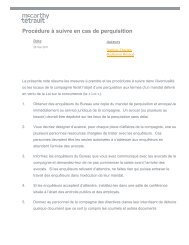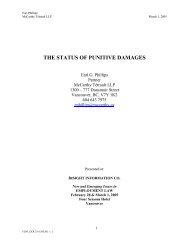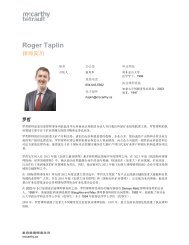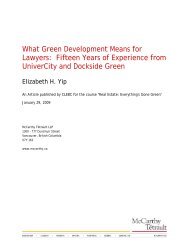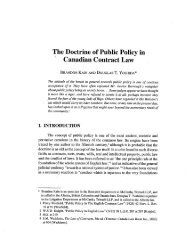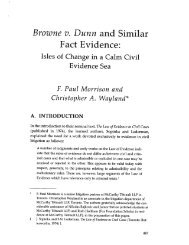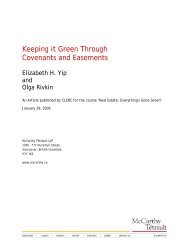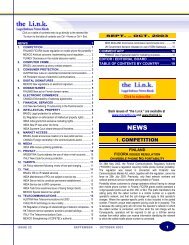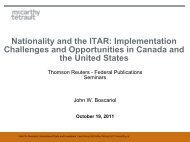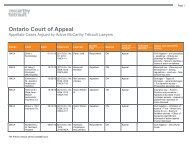Presentation Material - McCarthy Tétrault
Presentation Material - McCarthy Tétrault
Presentation Material - McCarthy Tétrault
You also want an ePaper? Increase the reach of your titles
YUMPU automatically turns print PDFs into web optimized ePapers that Google loves.
Chris Falk<br />
Stefanie Morand<br />
<strong>McCarthy</strong> Tétrault LLP<br />
sale proceeds payable by Newco would be a non-interest bearing demand promissory<br />
note payable by Newco in the amount of $1,000,000. 20<br />
• XCo would be wound-up into Newco on a tax-deferred basis. 21<br />
• Newco would use cash-on-hand (or other assets with only nominal gains) to repay all or<br />
part of the promissory note held by the estate.<br />
But for recent comments from the CRA suggesting that such a transaction might trigger a<br />
deemed dividend to the estate, tax practitioners had generally understood that the estate would<br />
receive proceeds on the promissory note on a tax-free basis given that the promissory note<br />
would have an ACB to the estate equal to its face amount.<br />
CRA’s Position Regarding Pipelines<br />
Concern that the CRA might take the position that a basic pipeline such as that described above<br />
could give rise to a deemed dividend to the estate pursuant to subsection 84(2) was raised in a<br />
CRA Round Table at the 2009 APFF Conference. 22 In the Round Table, the CRA did not take<br />
the position that subsection 84(2) applied in the example considered but, rather, declined to<br />
comment on the possible application of subsection 84(2) in the absence of more detailed facts<br />
than had been provided.<br />
The example considered in the Round Table assumed that a taxpayer, immediately prior to<br />
death, owned all of the shares of a taxable Canadian corporation, ACo, which had an FMV of<br />
$100,000 and an ACB of $100. ACo was assumed to have cash of $100,000, no liabilities,<br />
$100 in capital stock and $99,900 in retained earnings.<br />
Given the lower rates applicable to capital gains, it was proposed to use a pipeline in which the<br />
shares of ACo would be sold to a new taxable Canadian corporation, BCo, incorporated by the<br />
estate, for a non-interest bearing demand note in the amount of $100,000. Thereafter, ACo<br />
would be wound up into BCo, BCo would repay the $100,000 note payable to the estate and<br />
BCo would be dissolved.<br />
The pipeline transactions were intended to result in the estate acquiring the $100,000 subject<br />
only to tax on the capital gain on the ACo shares in the hands of the deceased taxpayer, as<br />
opposed to the estate receiving and being taxable upon a $99,900 deemed dividend if capital<br />
loss carry-back planning had instead been undertaken by way of a simple winding up of ACo<br />
into the estate pursuant to subsection 88(2). 23<br />
20<br />
21<br />
22<br />
23<br />
This example assumes that the $1,000,000 ACB to the estate is “hard ACB” for purposes of section 84.1 (i.e.,<br />
generally ACB not derived from pre-1972 gains or through the use of the capital gains exemption (subsection<br />
84.1(2))). Instead of a promissory note, Newco could issue redeemable, retractable preferred shares with a<br />
redemption amount and stated capital of $1,000,000.<br />
Alternatively, an amalgamation such as a short-form vertical amalgamation under section 87 could be<br />
undertaken.<br />
CRA Document No. 2009-0326961C6, dated October 9, 2009.<br />
Simplified, if ACo were wound up into the estate, assuming that the shares of ACo had PUC for purposes of the<br />
Act of $100, subsection 84(3) would deem the estate to have received a dividend of $99,900 (i.e., the $100,000<br />
paid less the $100 PUC). This deemed dividend would be excluded from the estate’s proceeds of disposition<br />
pursuant to the provisions of section 54 and, accordingly, the estate would have a capital loss of $99,900 given<br />
560600/422632<br />
MT DOCS 11864055v1G<br />
5



